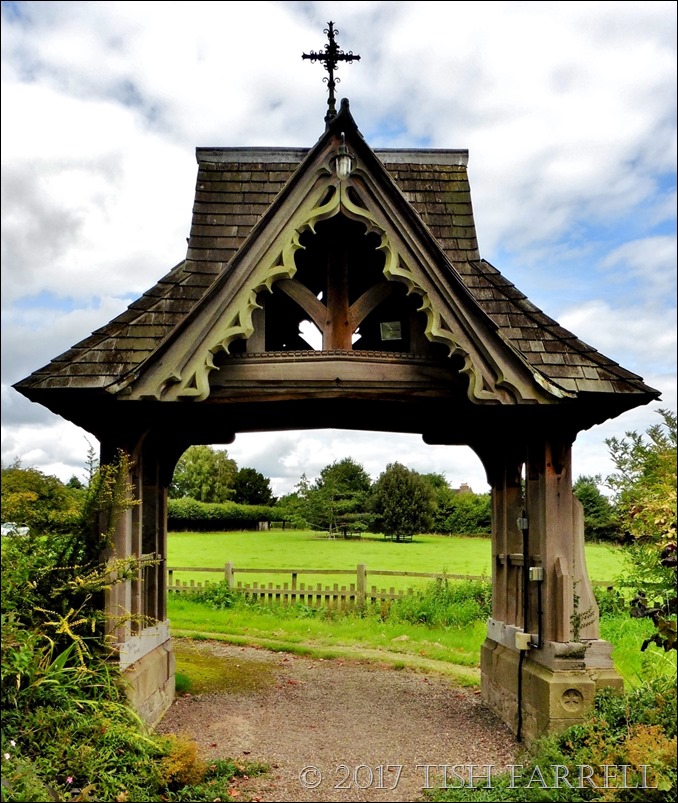
The lych gate is of course the corpse gate, the covered entrance wherein the dead might be laid until a funeral could take place in the parish church. In the past there was often a several day wait for this essential ceremony, during which time the deceased must be shielded from bad weather, robbers and worse.
This particular lych gate stands on the path to Morville’s parish church of St. Gregory. Morville, itself, is a small hamlet on the main road between Much Wenlock and Bridgnorth, and like Wenlock has a monastic past, although the church is all that remains of this period. I suspect that the fabric of the actual monastery may well have been re-purposed in the building of the next-door Morville Hall, which began hot on the heels of Henry VIII’s Dissolution of the Monasteries in the 1540s.

In Saxon times the place was a thriving manor, and after the Norman invasion of 1066, continued to be so, its existing church and associated lands bandied about as pieces of valuable real estate in deals between kings, earls and churchmen, its native inhabitants bound by fetters of superstitious dread and the obligation to provide wealth and labour for their overlords.
The Norman earl Roger de Montgomery took over Morville (along with most of Shropshire) in 1086. Here he had built a Benedictine monastery, an outpost for his more prestigious Shrewsbury Abbey some twenty miles away. He also had Wenlock’s Saxon priory remodelled on a monumental scale, and ordered the building of numerous other religious houses in every adjacent small community across the county.
I do not think this extensive building programme had much to do with piety. This was first and foremost about stamping Norman authority over the land. It was also an overlord’s means to control people, the wealth they created, and by the ordering of good works from the wealth accrued, so ensure his own place in heaven. It was his insurance policy in an era when everyone lived with a mortal terror of hell and the devil. As Baldrick in Black Adder might say it was a very cunning plan – political, physical and psychic control all of a piece – a top-down wealth management strategy.
If you go inside the church you may see, as you will in many old churches, the evidence of the psychic tyranny. The present building dates from the 1100s. Between the column arches on both sides of the nave, serpents slither down – an early medieval manifestation of ‘fake news’ perhaps? Imagine having them breathing down your neck every Sunday from infancy to grave. There was no opting out of the experience. Your very soul was in peril should you try to, and anyway this and the other snakes are endlessly hissing at the horrendous cost of becoming an outcast.

Even when the service is over – the mysteries of it conducted in a language you do not know, you are sent on your way by this jolly trio, just to reinforce the sense of threat for the rest of the week:

*
Today, the church in its country churchyard and the nearby hall are quintessentially scenic. My senses tell me that this is a lovely spot. But I confess, too, that increasingly I struggle with the rustically picturesque and the meaning I take from it.

*
For one thing, I still detect traces of susceptibility. The view of the hall, though presently owned by the National Trust, is still likely to induce a fit of the Downton Abbeys…
…that ultimately distasteful sense of nostalgia for a fake past of benign lords and grateful retainers. We may have Henry VIII to thank for loosening a little the stranglehold of the ruling elite, and broadening the class of major players to include merchants and professional men, but nearly five hundred years on, most of the country is still owned by small and powerful factions including the monarchy.
The fascinating thing is most of us don’t seem to notice, or realize how the way land continues to be controlled affects our lives in critically fundamental ways – the cost of a home – to buy or to rent – and the acceptance of ever-rising property ‘values’, the acceptance of mortgages for life. It is not for nothing that these holdings are referred to as ‘land banks’, or that any release of land for development is minutely managed to ensure maximum return from high priced, often poorly built, overcrowded properties.
We no longer have to plough milord’s fields, or give him our tithes in wheat and eggs, or bow to his whims, and tug forelocks, but the vestiges of feudalism are alive and well and residing in Britain, and more particularly, idling in its well-worn seats in the House of Lords, currently the focus of ‘a bit of a scandal’ as reported by the Electoral Reform Society. Of course we could do something about all this – if we really wanted to – if we stopped romancing about the past and started planning for a present that embraces everyone’s needs. It’s an interesting thought anyway.

Thursday’s Special: Traces of the Past
copyright 2017 Tish Farrell






















